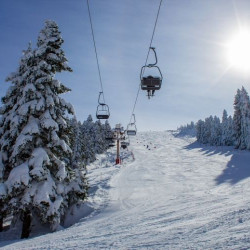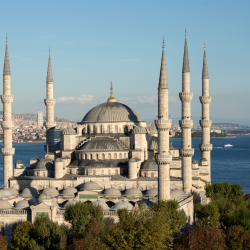Illumination Through Holy Wisdom – Hagia Sophia!
Early Byzantine records reaffirm the rabbinic belief that the divine Presence never departs from the Wailing Wall in the Old City of Jerusalem. Also, the emanation on the Wailing Wall is very much reflected in today’s Istanbul Jewish heritage sites.
Hagia Sophia even greater than Solomon’s Temple as the Byzantine emperor Justinian claimed? If indeed it is, what made Hagia Sophia even greater than Solomon’s Temple? The mystery lies where how Hagia Sophia was built. A temple above the Holy of Holies - Solomon’s Temple? The holiest shrine and its great architect mentioned in the Bible; is Hiram Abif - the Great Architect & The Temple of Solomon!
When Hagia Sophia was built, the main question was why Hagia Sophia was built. It indeed was unbelievably and miraculously great & so magnificent that this question remained unanswered for very long. The very answers to that question are also rooted deeply in the considerations regarding why is Hagia Sophia a wonder of the World. Holy Wisdom & Hagia Sophia - The Divine Sophia, in whom all things are created, is present in the Holy Trinity itself and how, as the "creaturely Sophia," dwells together with the eternal divine in the work of the Holy Spirit for the redemption of the world.
Secret & Hidden Knowledge
Indeed what and who surpassed Hiram Abif, the great architect of King Solomon's holy temple? Hiram Abiff, the master of geometry was the only one consecrated in the secret & hidden knowledge required to build this unique structure mentioned in the Bible! This engineering marvel of late antiquity certainly lifts up and exalts the minds with the feeling that God can not be far away, but rather surely dwells here. Hagia Sophia is God’s dwelling place!

Through metaphysical effects facilitating inner wisdom and outer manifestation; Hagia Sophia softens, enlightens, and heals in a physical, emotional, mental, and spiritual way, one feels surrounded in an oasis of calm, always fully aware of the fundamental 'all-rightness' of the world, regardless of transient circumstances.
The Mystery of Hagia Sophia
Witnessing such a Ptolemaic view of the universe, a masterfully combined design of Geometry, light, and cosmology! Understanding at once that it is not by any human power or skill, but by the influence of God that this church has been so wonderfully built. How excellent astronomical and optical considerations are closely associated with the phenomenon of light and vision! It gives peace and clarity radiating healing and love energy.
Such an aesthetic content of the architectural design - strong religious and cosmological beliefs have been symbolized through the use of geometry and the control of light using such a construction technique for a heptagon and reflecting mirrors that manipulate the light with accuracy. The aesthetics and ideology of light that is embodied in the architecture of Hagia Sophia abound exceedingly in sunlight and reflect the sun’s rays. Illumination through Holy Wisdom – Hagia Sophia! In light of creating an exquisitely proportioned religious space bathed in light, the architects of Hagia Sophia used sophisticated parametric digital tools and advanced lighting models.
Integration of Geometry, Light, and Cosmology
Through its design derived from the integration of geometry, light, and cosmology; With God’s presence, such an abundance of light bathes and blesses this shrine. Truly and verily, God’s presence is felt here in every sense of the word! In light of the legendary traditions regarding the construction of Hagia Sophia, deep speculations spread out all over Europe.
Since the impossible became reality; Such as the perfect proportions of this iconic building and the exact perfection obtained by superimposing a circle to a square, with the square tips on another circle, speculations turned out to be mysteries.
The Dome of Hagia Sophia
Verily and Easily; The famous Hagia Sophia is recognizable by its magnificent dome. How in the world did physicist Isidore of Miletus and the mathematician Anthemius of Tralles manage to sustain the 56 m high dome, 31 m wide, only on the walls of the church? And only with 10.000 workers in five years?
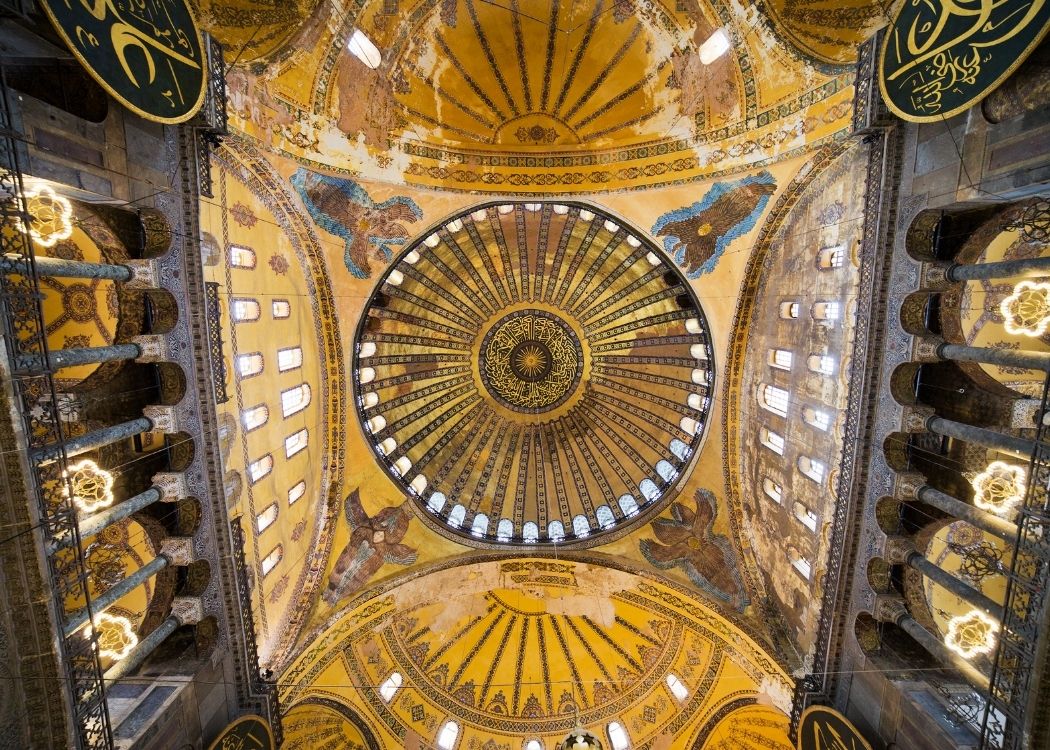
Just like the questions regarding the construction of the great Egyptian Pyramid “Cheops”; Hagia Sophia also presents a highly fictionalized narration of the circumstances surrounding the building of the church. The shape of Hagia Sophia also is linked up with the Ptolemaic view of the universe – Truly the inspiration and revelation of Holy Wisdom; A square (a cube), representing the Earth, with its cardinal points, and above a circle (half of a sphere), representing the sky and divinity.
The church of Hagia Sophia in Constantinople, through divine inspiration magnificently rebuilt by Emperor Justinian in the sixth century, and this architectonic, during the Middle Byzantine period the very object of a legendary elaboration that continued for several centuries.
The Legend & Secret - Hidden Knowledge Of Solomon’s Temple
Unearthly – Supernatural Forces... Angels helping Hagia Sophia– Demons helping Solomon... In recorded World history only two temples were built with the help of supernatural forces –Solomon’s Temple & Hagia Sophia!
As Justinian believed; The construction of the last and most glorious sanctuary of God had been reserved to The Byzantine emperor Justinian and Hagia Sophia was nothing less than the temple foretold by prophet Ezekiel. Hagia Sophia - the fulfillment of the final temple prophecy! As revealed, the supernatural angelic help received by Justinian for Hagia Sophia was higher and greater than what Solomon received.
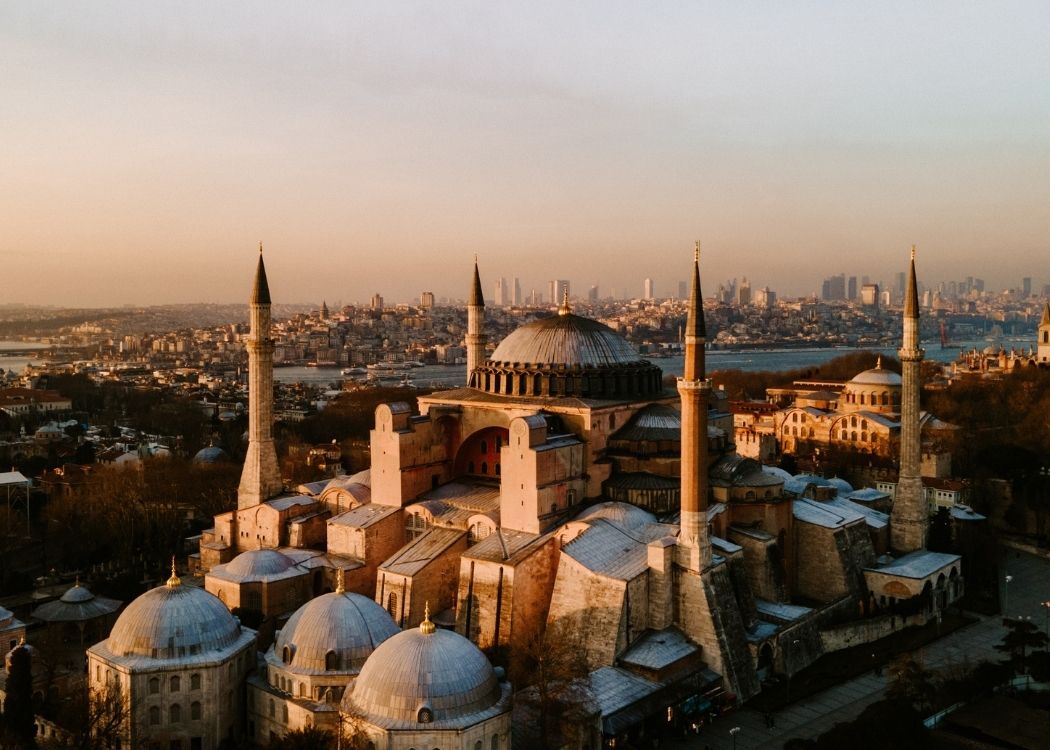
According to the biblical description of the construction of Solomon’s Temple (2 Kings 24: 1, 25; 3 Kings 5: 15-9: 25; 1), King Solomon wrote to King Hiram of Tyre to obtain from him cedar and cypress wood (3 Kings 5:15-26). He sent men to cut wood in Lebanon and quarry workers to extract stone of quality and he organized his workmen into teams under the direction of foremen (3 Kings 5:27-30). According to the second temple literature and to magical hermetic writings, King Solomon had supernatural powers such as the ability to control demons.
Solomon was even known to be a skilled exorcist and demonologist. Through deep association with unearthly forces, he used his control over demons to secure supernatural assistance for the building of the Temple of Jerusalem. The demons greatly helped Solomon during the erection of the Temple. King Solomon had entrusted two evil spirits of exceptional power, with the task of lifting and supporting the “aerial pillar” that had been brought from the Red Sea.
The Legend & Secret - Hidden Knowledge of Hagia Sophia
According to the legend, Through the emanation of God’s glory, the Holy Spirit, the immaculate mirror of his energy, angels literally participated in the construction of Hagia Sophia by training the workmen, adjusting the architectonic design, and even by building certain structures themselves. Sophia is the essence of the trinity, the glue that binds Father, Son, and Holy Spirit through the Glory of God obviously intended to represent a divine principle so that an angel was seen (ὁρατῶς) during the construction process “teaching the workmen” (τοὺς τεχνίτας διδάσκοντος) how to carry out their work.
To connect between the invisible and visible dimensions of reality, the divine Sophia who was ‘released’ from the triune God, appeared as creaturely Sophia,’ the entelechy and telos of the emerging World, and an angel disguised as Emperor Justinian. The Divine Sophia, the interior life of the Holy Trinity is characterized by “the principles of self-knowledge, self-revelation, and self-giving appeared to the master craftsman in the form of an angel and gave him precise instructions regarding the building of the vaults of the presbytery.
In the form of an angel, the divine Sophia wished the apse to have “three lights by means of the three galleries, in the name of the Father, the Son, and the Holy Spirit”. So that the Holy Wisdom could evoke Mary, the mother of Christ, and the Church, the bride of Christ, as well as Christ himself and the Holy Spirit. Emperor Justinian also had relics inserted inside the columns. To support the structure of the church, those relics were inserted inside of the 12 columns supporting the altar. Also, a few magic Apotropaic formulas were used. The verses from Psalms 46:5 were engraved in the bricks of clay used to build the arches that supported the dome.
Who Constructed Hagia Sophia?
According to the legend, supernatural forces also helped Justinian in funding the construction of Hagia Sophia as well. When the time came that workmen had reached the point of building the dome, Justinian had already spent all the gold of Byzantine for the construction. Justinian was very worried about finding enough gold to finish the construction.
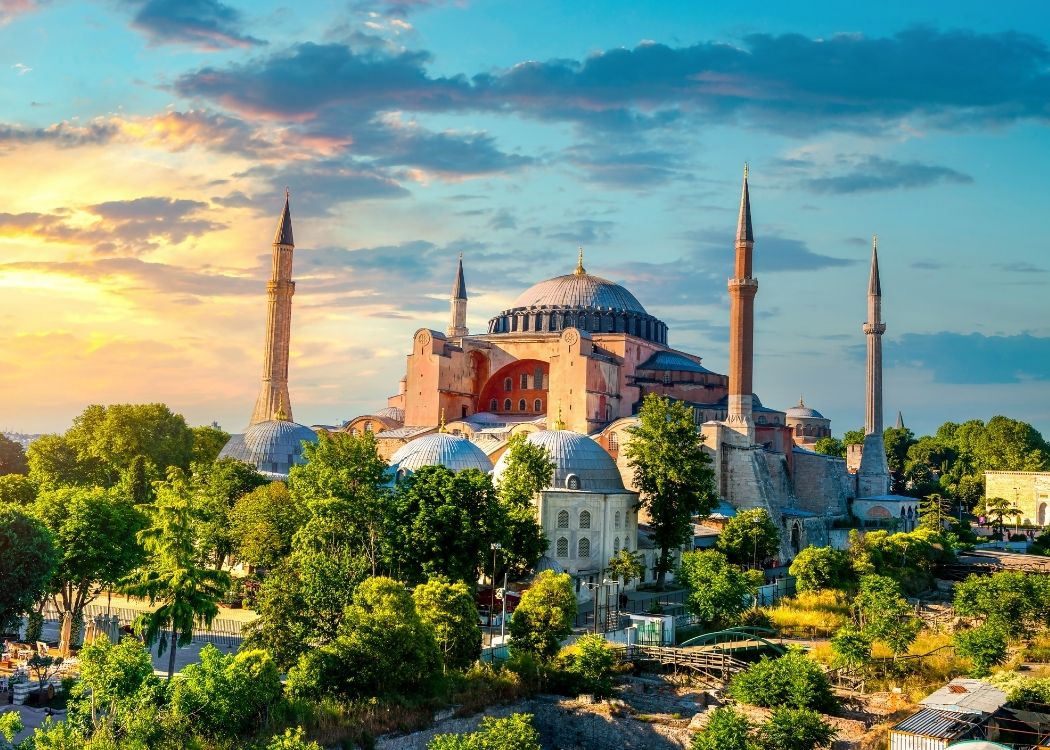
Right at that point, an angelic intervention happened again. An angel sent by Sophia appeared and promised to provide “as many gold coins (χρυσίου χάραγμα) as he wanted” for the construction of the church. Angel said, that in Hagia Sophia both God and humanity would be unified in one person. The next day, the angel had led the emperor‘s staff to a place near the Golden Gate and they had found an impressive treasure. Through this angelic help, Justinian could have continued the construction. Also, the legendary traditions regarding the construction of Hagia Sophia recall supernatural occurring through the intercession of a young boy, who was the son of Ignatius, the engineer (ὁ μηχανικός) in charge of the construction of the church.
This young boy was watching the construction tools left by the workers and an angel “disguised as a eunuch” appeared to the young boy. The angel “eunuch” wanted to know the reason why the building activities had been interrupted. Then the boy explained that the workers were taking their off time and resting. The angel “eunuch” immediately intervened and summoned all of them so that work could be immediately resumed. Finally, the last angel's supernatural intervention happened while the altar of the church was built.
The angel appeared and told the craftsmen to throw metals such as; gold, silver, bronze, electrum, lead, iron, tin, glass, and various types of precious stones into a melting furnace, and then to pour the mixture into a casting mold. This peculiar technique, which is an alchemical procedure, was regarded as the product of a supernatural intervention.
Therefore, right after this alchemical technique description had been revealed by the angel, the altar which was the work of “a divine force” (θείας δυνάμεως) appeared with all its beauty and offered itself as the most vivid and powerful imagery of the immanence of spirit in the life of this planet.
Holy Wisdom – Hagia Sophia; Transmutes all creation and our lives into something precious and sacred, to be loved, embraced, cherished, and celebrated because the life we see and experience here is the emanation of the divine ground.
Mosaics- Deisis Composition
People who visit the magnificent Hagia Sophia today enter a building heavy with faded glory & exquisite beauty. The remains of a magnificent mosaic, the Deesis seen with all its glory which is of extremely fine workmanship. The Deesis Virgin is composed of incredibly small cubes of glass and stone and was created to take advantage of the unique lighting of its position next to the great windows of the gallery. For Orthodox Christians, the icons and mosaics did not signify God, but they were seen as manifestations of God himself. Seeing a mosaic is interacting with it as a "living icon" which was an image of God full of spiritual energy.
Deesis; As beautiful as human hands could create, designed to appeal directly to multiple senses as a true 'memory' of Christ Himself, one that was immortally alive and perfect. Virgin Mary and John appear to be speaking to Christ, while he converses with us. Through Deesis we experience Christ, his Mother, and John as if we were present with them in a divine mystery play set in a cloud of the vivid gold mosaic that is eternally repeated.
Apse Mosaic - Theotokos and Christ Child
Indeed a solemn image of the Virgin, seated with the Christ Child on her lap in the apse, gazes down at the thousands who enter the museum. This figure seems stiff and hieratic to modern viewers.

When and Who Turn Hagia Sophia into a Mosque?
In every sense of the word, it is indeed worth mentioning that this mosaic was not covered up after the Muslim conquest in 1453 and it was visible for almost 300 years afterward. Millions of Muslims prayed under the mosaic for generations after the conversion of Hagia Sophia into a mosque. This is true of all of the mosaics in the apse. This continued until 1750 and then they were covered over with paint.
Rather than our contemporary understanding of ‘icon-mosaic’as portrait and image, Hagia Sophia presents eikon as enactment, the in-spiriting or empsychosis of pneuma in the matter. The Virgin who is located in the center of the apse semi-dome is represented enthroned with the Child seated in her lap. She rests her right hand on the Child's right shoulder, and her left, which holds a handkerchief, on the Child's left knee.
Eikon (icon) and mosaics in early Byzantium meant an enactment, causing the Holy Spirit to descend in the matter. The Virgin and the Child Christ figure is complete except for an area of loss (roughly o.80 m. high and 0.70 wide) on the left side of Mary corresponding to her left forearm and elbow, the Child's left hand, and part of the upper cushion placed on the throne.
The Byzantine mosaics were not static images. The mosaic is composed of a series of alternating layers of reflecting gold tesserae and light-absorbing dark glass tesserae. The Byzantine technique of installing mosaic tesserae causes the reflected light to create a sense of visual depth. When Pope Paul VI visited the Hagia Sophia in 1967, overwhelmed with emotion, he knelt in prayer when he first saw this stunning image. It was the first public demonstration of Christian prayer in Hagia Sophia since 1453.
According to the written sources, the icons and mosaics were commissioned by the Holy Wisdom – Hagia Sophia to defend the Orthodox faith. They had supernatural powers. They were perceived as living beings, they could move, speak and even fight with pagans, unbelievers, or sinners. In that sense, miracle-working mosaics and icons were regarded as the heroes of the Orthodox faith.
The Main Entrance - Nothing Came Down to Our Day of the Original Decor
There is no need to say how important was the symbolic concept of the main entrance to the “Magnificent Hagia Sophia” of the Byzantine Empire. Almost nothing came down to our day of the original but the molded brass frame of a doorway leading from the narthex to the nave, with a small relief portraying the Hetoimasia in the center of the top plate.
Today, the renowned mosaic in the Tympanum can be seen. It is above the entrance, representing Christ enthroned, with Emperor Leo the Wise at His feet. However, according to the written source references, there were originally two miracle-working icons on the sides of the Imperial Door – the icons of Christ and of the Virgin.
The written reference clearly states that nearly every church had its own system of relics and miracle-working icons creating a kind of sacred network inside a particular church.
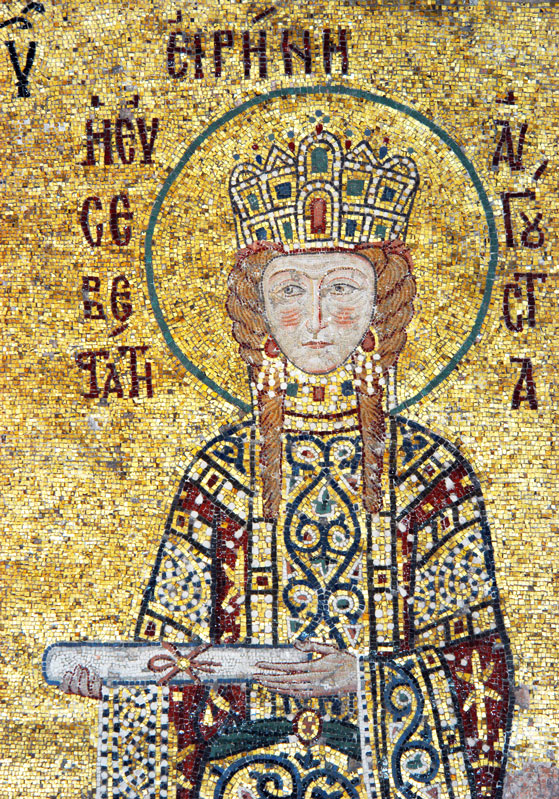
The written references of Russian pilgrims, Deacon Zosima (1419-1422), and Alexander the Clerk (1394/95) all mention that they were fairly large and made on boards or special panels at a height of nearly two meters in the marble facing the east narthex wall to the sides of the Imperial Door.
The exact written reference regarding the position of the Virgin icon at the main entrance to the church is; “In the right part of the church, behind the atrium, at the silver gates, there is an image of the Virgin on the wall, formerly preserved in Jerusalem; the one to which St. Mary of Egypt prayed in her time when she heard a voice coming from the lips of the Holy Mother of God. This holy image was brought to St. Sophia from the holy city by Emperor Leo”
Also, describes the solemn entrance of the patriarch to the church is described in detail in the written sources; “The patriarch comes downstairs to enter the narthex. When he gets close to the beautiful imperial doors, he does venerate the holy image of the Mother of God here, near which is an icon of St. Mary. The saint used to take her monastic vows before this very image of the Mother of God”
The miracle-working icon played a crucial element role in the symbolic program of the Royal Doors in Holy Wisdom - Hagia Sophia. In every sense of the word, it is excruciatingly painful to see that the only surviving part of it is what we can see now which is the Tympanum mosaic with Leo the Wise bowing before Christ enthroned.
The Doors of Hagia Sophia
The Imperial Door - The Wood of Noah’s Ark The Patria of Constantinople (Πάτρια Κωνσταντινουπόλεως), also commonly referred to by the Latin name “Scriptores origanum Constantinopolitarum” ("writers on the origins of Constantinople"), is a Byzantine collection of historical art on the monuments of the Byzantine imperial capital of Constantinople.
The written references on the construction of the Hagia Sophia included in the “Patria Constantinopoleos” clearly states;
“In the second narthex, it was the ivory which the doors were made of (three to the right, three to the left, and between them) three other doors: two of the middle size, and between them, there was the very big one of gilded silver. All the doors were gilded. It was not the regular wood inside these doors but “the Wood of the Ark”.
According to those references, the door was covered by sheets of silver gilt and it had a big - impressive silver lock on it. The door also had two other names such as Silver Gates and the Beautiful Gates. There were two icons hung on each side of the door - the Savior and one Mary of Egypt and the Theotokos – which were brought to Hagia Sophia the Holy Sepulchre in Jerusalem. It was also known as the “Door of Repentance,” and there was a mosaic of the Byzantine Emperor Leo the Wise above in the arch.
Aural Manifestations of Reflection
Hagia Sophia became a metaphor for heaven and it is indeed a deep source of architectural revelations. As a monument of Byzantine spirituality, it is the connection between the divine and the mortal, the eternal and the temporary, the transcendental and the immanent.
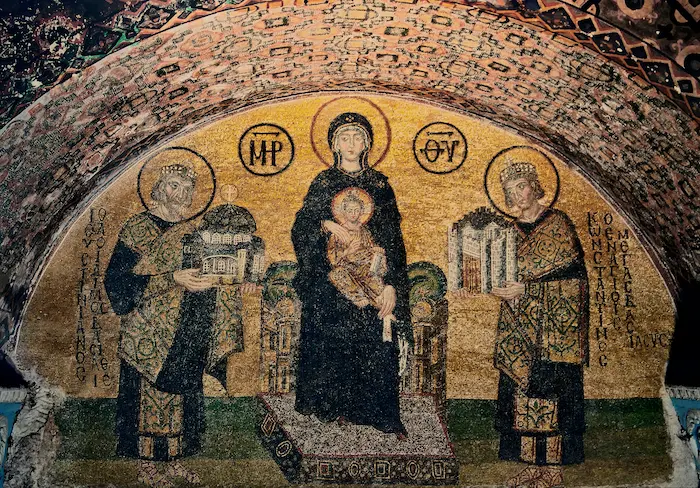
As an architectural masterpiece believed to be truly miraculous, Hagia Sophia - Istanbul, Turkey challenges the contemporary expectation of the intelligibility of language. The structure itself accepted as a gift from God evokes the heavenly sanctuary. Hagia Sophia in Istanbul, with its impressive abundance of over ten different types of marble carefully arranged to adorn its walls and floor. There are more than fifty marble columns throughout the church. The marble in Hagia Sophia visually simulates the quiver of water as light streaming through the windows animates the polished surfaces. Hagia Sophia abounds exceedingly in sunlight and the reflection of the sun’s rays from the marble.
Where is the Hagia Sophia Mosque?
Located in the Sultanahmet area - the Old City Istanbul, the in-depth discovery of this spectacle of marvelous beauty Holy Wisdom – Hagia Sophia means every opportunity explored to experience sensory and ephemeral nearness to divinity. Having a very experienced guide without waiting in the ticket entry line creates a sensorial field in which the metaphysical can be experienced in the phenomenal. The best experience comes through skipping the ticket line with a guided tour.
Hagia Sophia to Grand Bazaar
The Old City Istanbul is the heart of the city and is the perfect place for sightseeing. Discovering the Sultanahmet area with an Old City Tour and visiting historic – ancient sites in the same area such as; Basilica Cistern, Topkapı Palace Museum, Hagia Irene Museum, and the mysticism of Hagia Sophia to Grand Bazaar truly gives such a breathtaking experience.
While Grand Bazaar Istanbul proudly reveals the great secrets of shopping in Istanbul, a Princes' Islands Boat Trip in Istanbul gives the luminosity and visual appearance of lavish colorful, and brilliant ornaments of beauty. Come and discover the full history of Holy Wisdom-Hagia Sophia and have a wonderful – easy – fast visit in detail With Us!
The Architecture of Ayasofya is a Magnificent Imperial Artifact
Hagia Sophia’s tall “Imperial Door” is at the center of the museum entrance inside the courtyard. A mosaic panel that was completed in the Ninth Century is located directly above this door. Portraits of the Virgin Mary and the Archangel Gabriel are found on the medallions to either side of this mosaic.
Hagia Sophia’s most magnificent feature is certainly its great dome, which rests as though hung from the air itself, and encloses the entire building. Its walls and ceiling surfaces are covered with multi-colored marble and mosaics. The 107 columns that are found on both the bottom floor and on the mezzanine are characteristic examples of decorative art from the Byzantine Empire in the Sixth Century. The deeply hollowed-out marble columns, so characteristic of that era, play lovely games with the shadows and interior light. In the middle of these columns, the imperial monogram is found. At the apex of the half-dome, a mosaic of the Virgin Mary with Baby Jesus resting in her lap can be seen, while to the right is a mosaic of the Archangel Gabriel.
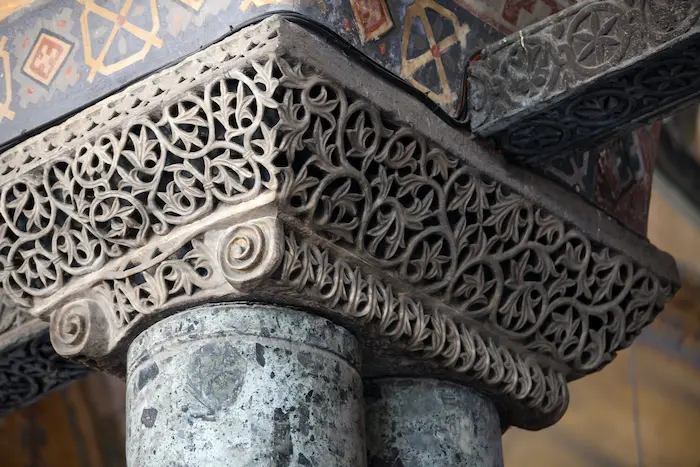
The large circular disks made from leather, hang on the walls at the mezzanine level, and the inscriptions on the dome testify to the building’s use as a mosque. The calligraphic works on the dome and disk are each masterpieces written by famous master calligraphers who lived in the middle of the Nineteenth Century. The names Allah, Hz. Mohammed, 4 Caliphs, and Hasan – Huseyin are written on the circular panels.
At the north corner of the building, one finds the “crying pillar”. At the bottom portion of this pillar, there is a hole surrounded by a bronze band. According to an ancient tradition, if you place your finger into this hole and make a wish, your wish will surely be granted…
In the north wing of the building, a single mosaic panel is found, while in the south wing, one encounters three mosaics each depicting three figures. In the south gallery, a masterpiece of Byzantine mosaic technique is found, delicately placed in the sunshine that enters from an adjacent window. Here, you will find a mosaic known as “Diesis”, which depicts three figures on Judgment Day. Jesus is in the middle of this panel, with Mary on his right and John the Baptist on his left. As you leave the museum through the exit corridor, you can see a giant mosaic panel that dates from the Tenth Century. The figures in this mosaic, which are out of proportion, include the Virgin Mary and the Baby Jesus. On either side of the mosaic, there are depictions of Constantine the Great holding a model of the city and the Emperor Justinian holding a model of Hagia Sophia. Finally, at the exit, one finds a pair of bronze doors, partially sunken in the ground, which date from the Second Century B.C.E. and are thought to have been brought to the site from a Pagan temple.
Ayasofya, which continued to exist as a mosque throughout the Ottoman Period, was the object of the special interest of all of the sultans. Over time, the building was filled with objects unique to the culture of the Ottoman period. In this way, the building remains today as a masterpiece that displays the influence of each of the two religions and cultures. The tombs found in Hagia Sophia, with interior decoration, tiles, and construction, are wonderful classic examples of traditional Ottoman tomb design.
Hagia Sophia Mosque Today
Hagia Sophia, originally built as a cathedral underwent a significant transformation in 2020 when it was repurposed as a mosque, marking a pivotal moment in its storied history. This architectural marvel, with its fascinating blend of Byzantine and Ottoman influences, now stands as a symbol of Istanbul's cultural richness. Today it continues to serve as a religious temple, as a mosque.
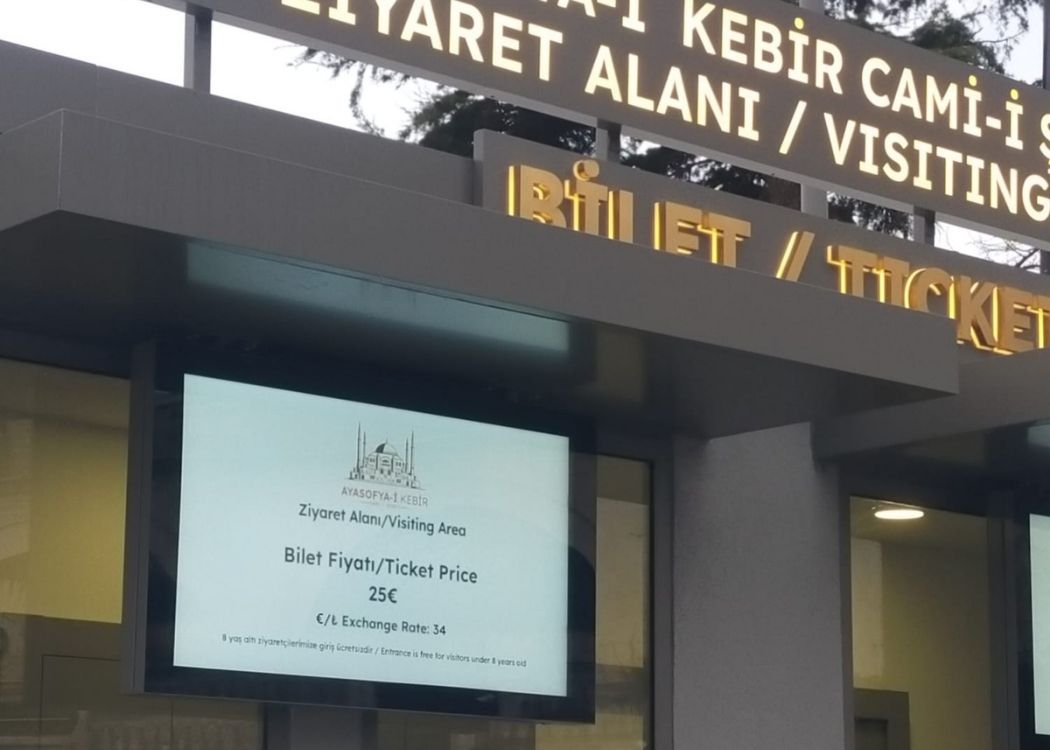
As of January 15, 2024, a new policy has been implemented at Hagia Sophia, ushering in changes for visitors. A modest entrance fee of 25 euros is now required, providing access to the 2nd-floor visitor areas while maintaining restrictions on entry to the prayer area. Notably, the longstanding tradition of guided tours within the historic structure has been discontinued. Visitors should be mindful of potential queues as the site adjusts to limited capacity.
Despite these adjustments, the essence of Hagia Sophia persists, offering a profound experience to those who explore its hallowed halls. The amalgamation of history, art, and architecture continues to captivate, making each visit a journey through time and culture within the contextual backdrop of its recent transformation into a mosque.
 English
English  Indonesian
Indonesian  Urdu
Urdu  Taiwanese
Taiwanese  Russian
Russian  Romanian
Romanian  Portuguese
Portuguese  Persian
Persian  Macedonian
Macedonian  Korean
Korean  Japanese
Japanese  Italian
Italian  Indian
Indian  Hungarian
Hungarian  Greek
Greek  German
German  Croatian
Croatian  Chinese
Chinese  Bulgarian
Bulgarian  Arabic
Arabic  French
French  Spanish
Spanish 











